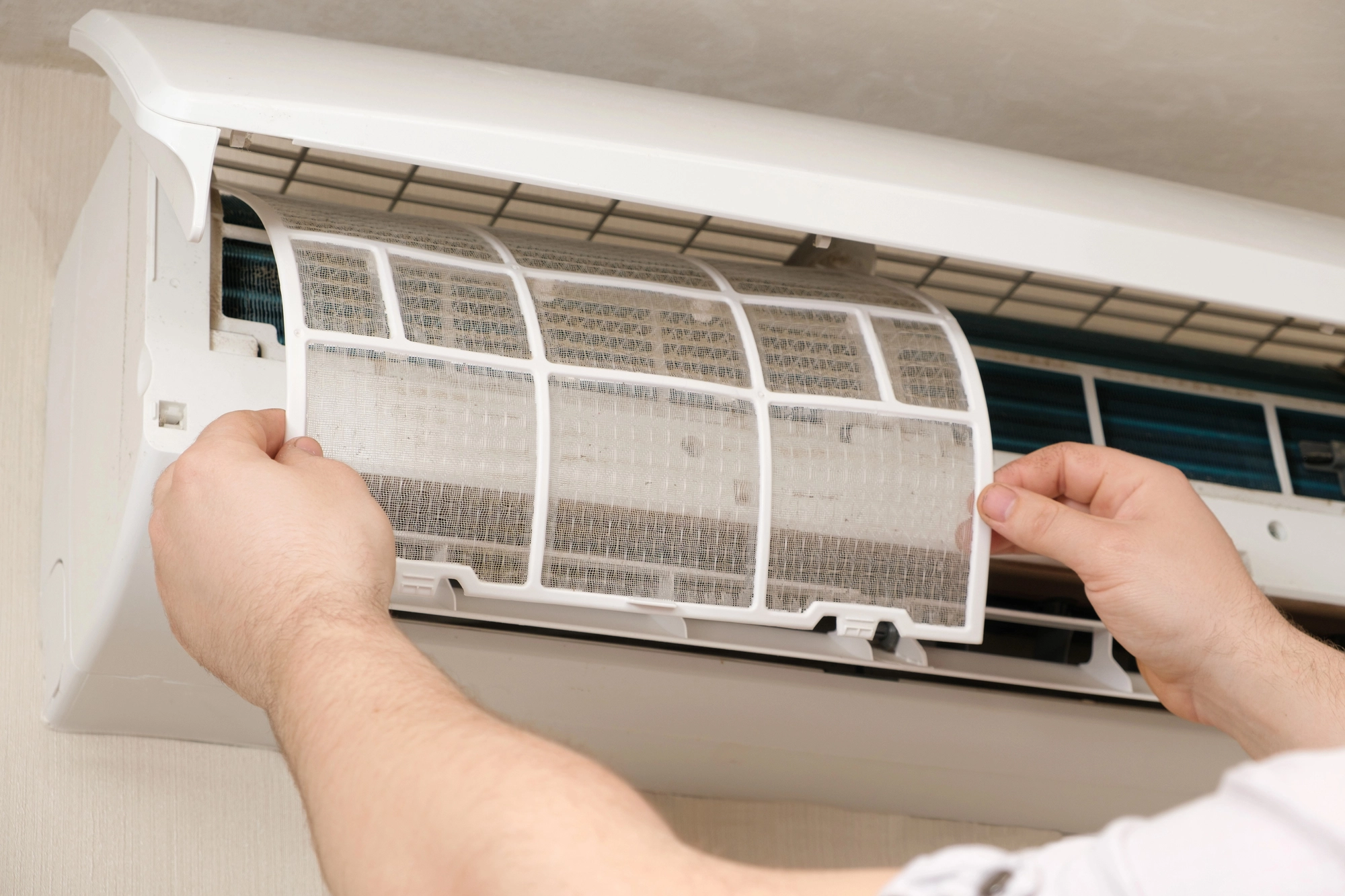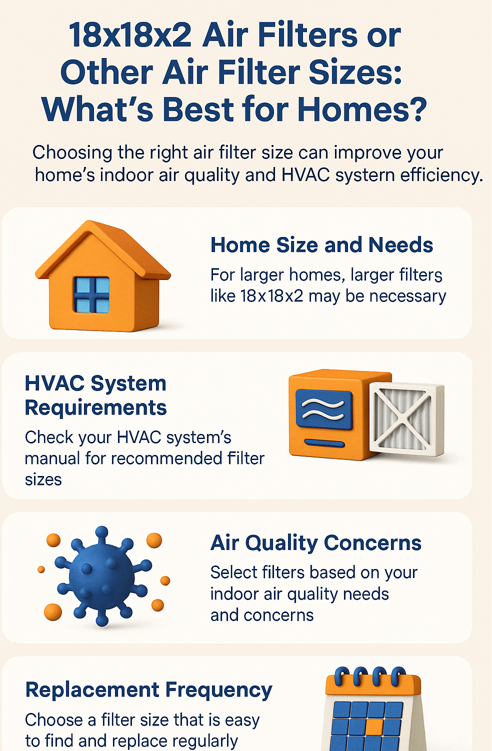Which Air Filter Size Works Best for Homes? A Guide to 18x18x2 and Alternatives
From years of testing different air filter sizes in real homes, one lesson is clear: the size you choose impacts far more than just the fit in your HVAC system. Homeowners often wonder if 18x18x2 air filters are the best choice, or if another size might deliver cleaner air and lower bills. Based on field experience, we’ve seen that the 18x18x2 size strikes a balance many homes need—strong airflow, solid dust capture, and dependable system protection—while other sizes may be better for unique layouts, larger households, or allergy-sensitive families. In this guide, we’ll share firsthand comparisons, highlight when 18x18x2 filters shine, and explain when switching to a different air filter size could actually improve comfort, efficiency, and long-term savings.
Top Takeaways
- 18x18x2 filters = reliable, balanced airflow + dust control.
- Size matters → wrong size can raise energy use by 15%.
- Match to needs → larger for pets/allergies, smaller for compact units.
Replace regularly → 60–90 days (standard), up to 6 months (thicker).
Choosing the right air filter size is one of the most overlooked steps in maintaining a healthy and efficient home. While 18x18x2 air filters are a standard choice for many households, they’re not the only option—and size really does matter.
An 18x18x2 filter is valued for its balance: it provides a snug fit in most mid-sized systems, allows strong airflow, and captures common pollutants like dust, pollen, and pet dander without overworking the unit. In our experience, this size often works well for families seeking reliable everyday protection without sacrificing HVAC efficiency.
Other air filter sizes may be better suited if your home has larger square footage, higher dust loads, or specific allergy needs. For example, thicker filters like 4- or 5-inch options can trap more particles and last longer, while smaller sizes may need more frequent replacement but fit compact systems.
Ultimately, the best choice depends on your system’s design and your household’s priorities. If comfort, cost savings, and cleaner air are top goals, starting with an 18x18x2 filter is a solid move. But knowing your full range of air filter sizes—and when a switch makes sense—gives you control over both your indoor air quality and long-term HVAC performance.

"In our hands-on work with homeowners, we’ve found that 18x18x2 air filters strike a sweet spot—offering reliable airflow and dust capture without straining the HVAC system. But we also advise families to look beyond just the standard size. Larger or thicker filters can extend replacement cycles and improve allergy control, while smaller filters may be necessary for compact units. The key is matching the filter size not only to the system specs but also to the unique lifestyle and air quality needs of the household."
Case Study & Real-World Examples
1. The Martinez Family – Dallas
- Used an oversized filter → poor airflow, more dust, worse allergies.
- Switched to a properly sized 18x18x2 filter (high MERV).
- Results: smoother airflow, less dust, fewer allergy flare-ups in 2 weeks.
- Technician confirmed: correct size matters more than just thickness.
2. Compact Units vs. Large Homes
- Large homes with pets: 4-inch filters work better.
- Results: better dust control, replacement only 2x a year (vs. every 2–3 months).
3. Industry + Field Insights
- Wrong filter size can raise energy use by up to 15%.
- Field checks show: forced or oversized filters restrict airflow and wear out systems.
- Best results come from matching filter size to system design + household needs.
Supporting Statistics & Field Insights
1. Filter Care and HVAC Lifespan
- Dirty filters shorten system life.
- DOE research: preventing filter/coil fouling saves up to 30% annually.
- Field insight: clogged filters in 100 °F+ heat often cause early failures.
- Source: DOE/ORNL Study
2. Efficiency vs. Resistance Tradeoff
- EPA: MERV 13 removes 3× more fine particles (1–3 µm) vs. MERV 8.
- Caution: higher resistance if filters clog or are oversized.
- Source: EPA Guidance
3. Air Quality Gains vs. Energy Impact
- EPA rooftop unit testing: upgrading MERV 8 → MERV 13/14 raises energy use 2–4%.
- Air cleaning improves nearly 3–4× for PM2.5.
- Our experience: families with asthma/allergies find benefits outweigh cost.
Source: EPA HERO Database
Final Thought & Opinion
Key Point: Choosing between 18x18x2 air filters and other sizes isn’t only about fit. It’s about clean air, comfort, and HVAC health.
What We’ve Seen in the Field
- 18x18x2 filters: balance airflow + filtration, reduce dust, keep bills stable.
- Larger filters: better for multi-pet homes or heavy dust; last longer.
- Smaller filters: fit compact units where space is limited.
Our Opinion
- Don’t choose by size alone.
- Match the filter to:
- System design
- Household lifestyle (allergies, pets, maintenance needs)
Bottom Line
- Start with the manufacturer’s recommended size (often 18x18x2).
- Adjust only if real-world needs show a better fit.
The right filter size = cleaner air, fewer breakdowns, healthier living.
Next Steps
- Check Your Filter Size
- Read the label or measure the frame.
- Confirm if it’s 18x18x2 or another size.
- Review Household Needs
- Allergies, pets, heavy dust → higher MERV or thicker filters.
- Small homes, light use → standard 18x18x2 works well.
- Match to HVAC System
- Follow manufacturer’s recommendations.
- Don’t force filters that don’t fit.
- Set a Replacement Schedule
- Standard: every 60–90 days.
- 4–5 inch filters: up to 6 months.
- Track Performance
- Watch airflow, dust, or allergy symptoms.
- Adjust size or type if needed.
- Act Now
- Confirm your filter size.
- Order replacements online or locally.
Keep spares ready for quick changes.
Frequently Asked Questions
1. What is an 18x18x2 air filter used for?
An 18x18x2 air filter is commonly used in residential HVAC systems to trap dust, pollen, and other airborne particles while maintaining proper airflow.
2. How often should I replace an 18x18x2 air filter?
Most 18x18x2 filters should be replaced every 60–90 days. Homes with pets, allergies, or heavy dust may need replacements more often.
3. Are 18x18x2 air filters standard size?
Yes, 18x18x2 is a standard size, but always check your HVAC manual or measure your current filter to confirm compatibility.
4. What MERV rating is best for an 18x18x2 air filter?
For most homes, a MERV 8–11 filter provides good dust and allergen control. For households with allergies or asthma, a MERV 13 may be better.
5. Where can I buy 18x18x2 air filters?
They’re available online, at home improvement stores, and HVAC suppliers. Buying in bulk can save money and ensure replacements are always on hand.
Learn more about HVAC Care from one of our HVAC solutions branches…
Filterbuy HVAC Solutions - Miami FL - Air Conditioning Service
1300 S Miami Ave Apt 4806 Miami FL 33130
(305) 306-5027
https://maps.app.goo.gl/Ci1vrL596LhvXKU79





